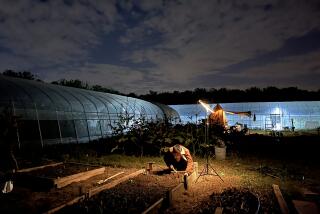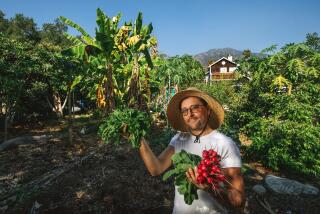Egypt’s Farmers Reap Desert Crops : Greenhouse ‘Tunnels’ May Ease Need for Food Imports
- Share via
BENI SUEF, Egypt — The fertile Nile valley can no longer feed Egypt’s masses, but a wave of technically trained new farmers is moving into the cheap desert lands near here and erecting plastic-covered “tunnel” farms in a bid to help the country fight its way back to self-sufficiency in food production.
“Give me a piece of desert, and in six months’ time I can make money out of it,” said a confident Ahmed Nassar, chairman of a 2-year-old agribusiness, Plant Production Co., whose first-year crop yielded 900 tons of vegetables from a surprisingly small patch of desert near the provincial capital of Beni Suef, 80 miles south of Cairo.
The grizzled old Nile farmers regard with uncertainty and a little disdain the neat rows of military-like structures covered with plastic and outfitted with irrigation hoses, ventilation systems and heaters.
Hefty Dividends
But Nassar and other Egyptian tunnel farmers are gambling that high-quality vegetables produced under the plastic coverings will bring hefty dividends not only in Egypt, but also in the wintertime European markets.
By moving into the desert, these new farmers also are freeing land for critically needed wheat production in Egypt. The Agriculture Ministry hopes that by moving much of Egypt’s vegetable production into the desert, the country can reclaim 2 million acres in the Nile valley for wheat production over the next five years.
Once a granary of the Roman Empire, Egypt was still self-sufficient in food production as recently as two decades ago. But its mismanaged farmlands, tangled price and subsidy systems and population boom have sapped agricultural production and driven the government to more and more food imports.
Agricultural Waste
Today, with a population of 50 million--growing by 1 million every nine months--Egypt imports well more than half its food.
The agricultural waste here can easily be seen. Thousands of acres of tomato plants died this year, from an easily preventable virus, because government budget cutbacks have decreased the number of farm agents who give free advice on the use of pesticides.
The U.S. Food for Peace program, the greatest contributor to Egypt’s grain silos at an annual cost of $200 million, now aims at slowly weaning Egypt from food dependency by encouraging more efficient use of its land.
A number of agricultural experts believe that Egypt’s 6 million acres of farmland are enough to sustain its population, but only with a vigorously managed agricultural program and only after making it more attractive to farmers to grow staples such as wheat and corn.
“Why should the farmers plant wheat when they know they will take a loss?” Nassar asked.
Get Production in Line
Egypt will have to do something to get its food production in line with consumption if it is to feed the estimated 70 million Egyptians who will populate the narrow Nile corridor by the end of the century.
Although greenhouses have been used successfully in other parts of the Middle East for years, there were virtually none in Egypt until the 1980s.
The greenhouses’ modern plastics filter out all but the best growing rays of the sun in an environment protected from wind, cold and sandstorms.
Water, fertilizer and humidity are controlled, producing better crops that bring top market prices that help to repay quickly the costs of building a “tunnel” farm.
More to Read
Sign up for Essential California
The most important California stories and recommendations in your inbox every morning.
You may occasionally receive promotional content from the Los Angeles Times.










